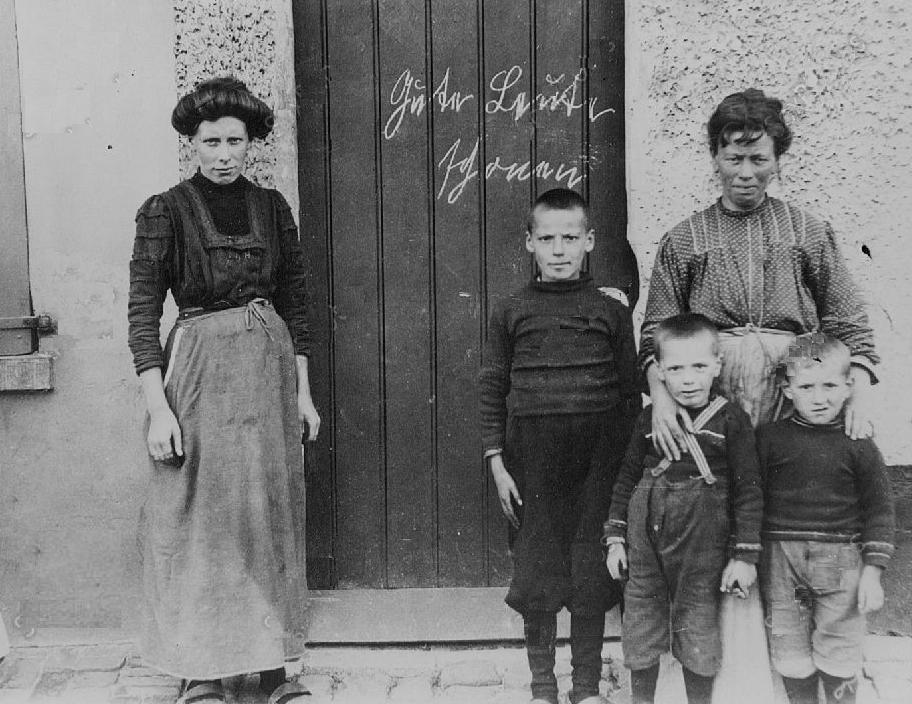
World War I Belgium: German Invasion--Behavior of German Troops (August-November 1914)

Figure 1.--There are few actual photographs illustraring the German Rape of Belgium. Most of the most notorious incidents are depicted by illustrations which of course are not reliable evidence. Here is an actual photograph of an unidentified Belgian (or perhaos family in northern France) victimized by the advancing Germans. German soldiers after looting the family have scrawled in German Gothic script what a French reader tells us looks like, "Gute Beute, schonen." That means, "Good loot. Take care." A German reader sees a different message.
|
|
There are few actual photographs illustraring what during the War became known as the German Rape of Belgium. Most of the most notorious incidents are depicted by illustrations which of course are not reliable evidence. Here is an actual photograph of an unidentified Belgian (or perhaps family in northern France) victimized by the advancing Germans. German soldiers after looting the family have scrawled in German Gothic script what a French reader tells us looks like, "Gute Beute, schonen." That means, "Good loot. Take care." A German reader sees a different message. He tells us, "The writing on the door is interesting. It shows the reading problems with the Sütterlin-writing in the early-20th century. I have attached a writing table (an example of very nicely written text). The capital letter 'B' and 'L' are not very different. Thus, the second word may read 'Beute' (loot/haul/swag) or 'Leute' (People). From the context 'take care' it may mean 'good people, take care'. I am not trying to make an excuse for all the well documented crimes like looting the Germans troops committed in World War I, just pointing out the difficulty with the lexicography. And it needs to be mentioned that not all German troops behaved brutally. Sütterlin is an offspring of the Altdeutsche Schrift in use 1912+/1915. My grandparents, grandmother always and my grandfather privately (not in his work) used it. My mother (born 1907) learned it in primary school, in the secondary school with foreign languages she learned and wrote in Latin writing (as we do now). I myself can still read (with some effort) both the Altdeutsche Schrift (better) as well as Sütterlin."
CIH -- WW I

Navigate the CIH World War I Pages:
[Return to Main German Rape of Belgium page]
[Return to Main World War I Belgium: German invasion page]
[Return to Main World War I Belgium page]
[Return to Main World War I country page]
[Return to Main World War I conduct page]
[Return to Main Belgian history page]
[Return to Main Belgian page]
[About Us]
[Aftermath]
[Alliances]
[Animals]
[Armistace]
[Causes]
[Campaigns]
[Casualties]
[Children]
[Countries]
[Declaration of war]
[Deciding factors]
-------[Diplomacy]
[Economics]
-------[Geo-political crisis]
[Home front]
[Intelligence]
[Military forces]
[Neutrality]
[Pacifism]
[People]
[Peace treaties]
[Propaganda]
[POWs]
[Russian Revolution]
[Signals and intelligence]
[Terrorism]
[Trench warfare]
------[Technology]
------[Weaponry]
[Bibliographies]
[Contributions]
[FAQs]
[Images]
[Links]
[Registration]
[Tools]
[Return to Main World War I page]
[Return to Main war essay page]
[Return to CIH Home page]
Created: 6:36 PM 11/27/2016
Last updated: 6:36 PM 11/27/2016



